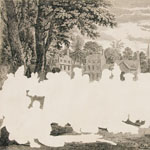 |
Commissioned in 1773 by William Penn’s son Thomas as a device to curry favor with the disillusioned citizenry of Philadelphia, this print, issued by premier London publisher John Boydell (1719-1804), took two years to complete. Over that time, John Hall (1739-1797), an engraver of Penn portraiture, toiled away on the printing plate from which several proofs were produced by Boydell’s press. Although Hall’s name adorns the finished print as the engraver, often several persons may have worked on one large plate. Given the state of this proof, it appears that a landscape specialist had completed his section of work. John Hall, experienced in the engraving of human figures, had yet to execute his rendering of Penn, his party, and the Delaware Indians within the outline. |
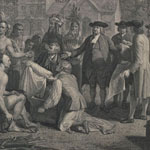 |
John Hall after Benjamin West. Wm. Penn's Treaty with the Indians, when he founded the Province of Pensylvania in North America 1681 (London: Published by John Boydell, June 12th, 1775). Engraving. Gift of Thomas Ridgway.
|
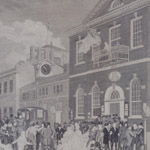 |
Alexander Lawson after John Lewis Krimmel. The Election Day in Philadelphia (Philadelphia, ca. 1894). Engraving.
Although a proof in concept, this engraving by Alexander Lawson (1773-1846) after the painting Election Scene. State House in Philadelphia (1815) by John Lewis Krimmel (1786-1821) represents the final state of the print produced from an unfinished plate. Lawson, a friend of Krimmel and owner of the original painting, never completed the plate that he worked on intermittently between 1821 and his death in 1846. In 1887, one of the engraver’s daughters deposited the plate at the Pennsylvania Academy of the Fine Arts, from which the museum created forty-two restrikes, including this print. The engraving evokes the feeling of a piece of abstract art and serves as a visual tool of the printmaking process. |
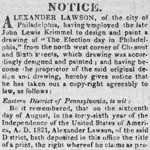 |
Alexander Lawson. Notice in Poulson’s American Daily Advertiser, August 18, 1821. Modern reproduction.
Often 18th- and 19th-century printers and engravers used the press to declare their intention of publishing a print, as Lawson did when he announced that he had acquired the copyright to the Krimmel painting, a first step in the creation of an engraved reproduction. |
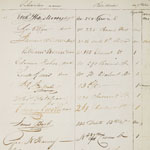 |
Cephas G. Childs. Original subscription book for Childs’s Views in Philadelphia (Philadelphia, ca. 1825-1831). Acquired from the Jay T. Snider Collection.
In 1825 Philadelphia engraver Cephas G. Childs (1793-1871) conceived of an ambitious project consisting of thirty-two to forty engravings of “important and interesting Public buildings” and scenes “most remarkable for beauty” made available to subscribers in eight to ten numbers each with four plates. Almost all of the approximately 350 names recorded in this book subscribed to the largest size pages offered by Childs and agreed to pay $1.75 upon delivery of each number. Subscribers included members of Philadelphia’s most prominent families, including the Biddles, Norrises, and Cadwaladers, well known artists such as John Rubens Smith (1775-1849), Edward Clay (1799-1857), and Gideon Fairman (1774-1827), and institutions such as the Library Company. Samuel George Morton (1799-1851), a physician and physical anthropologist, agreed to subscribe as long as the series included a view of the Academy of Natural Sciences. |
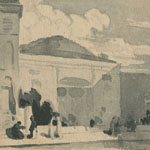 |
[Cephas G. Childs]. [Pennsylvania Academy of the Fine Arts], ca. 1826. Watercolor on paper.
The Library Company’s collection contains studies and completed engravings from Childs’s Views in Philadelphia. This study is one of six rough gray wash sketches probably executed by Childs to provide guidance to the artists he commissioned to work on Views in Philadelphia. |
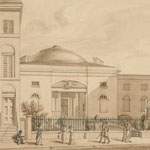 |
Alexander Lawson. Notice in Poulson’s American Daily Advertiser, August 18, 1821. Modern reproduction.
Often 18th- and 19th-century printers and engravers used the press to declare their intention of publishing a print, as Lawson did when he announced that he had acquired the copyright to the Krimmel painting, a first step in the creation of an engraved reproduction. |
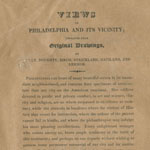 |
Views of Philadelphia, No. 2 (Philadelphia: Cephas G. Childs, 1828). Gift of David Doret.
Although Childs had promised that numbers would be published every three months following the initial December 1827 issuance of the first, the actual release dates stretched out over a period of two years. Each number, like this one, was bound with an engraved cover and included a prospectus, pricing, and subscription information on the back cover. |
 |
Cephas G. Childs. Pennsylvania Academy of the Fine Arts in Views in Philadelphia (Philadelphia: C. G. Childs, 1828). Engraving after drawing by George Strickland. Gift of Frances A. Logan.
This print, now with the seated figure removed, was originally issued in 1828 as a plate in the fourth number. When the sixth and final number was issued, bringing the total to twenty-five prints (not the thirty-two to forty prints mentioned in the proposal), Childs also included an engraved title page, additional pages of text, a subscribers list, and a binder’s list which served as a table of contents. The engravings in the Library Company’s two bound copies are not in the same order as that list, showing that binders did not always follow the suggested order. Childs’s project put into a single volume views and brief descriptions of churches, banks, and educational and cultural institutions created by leading artists and architects including George and William Strickland, Thomas Birch (1779-1851), Edward Clay, and Thomas Sully (1783-1872). C. G. Childs had, in his own words, succeeded in creating a “permanent memorial of our City and its institutions” while exhibiting “a creditable specimen of the state of the Fine Arts in Philadelphia.” |








